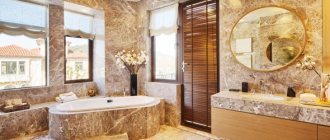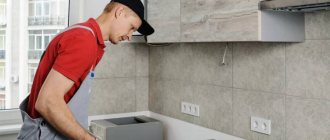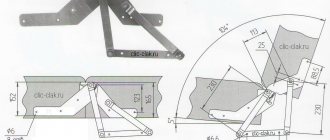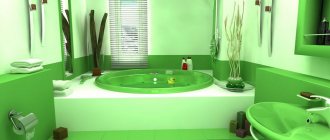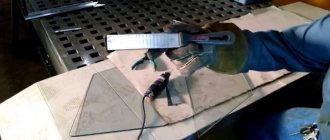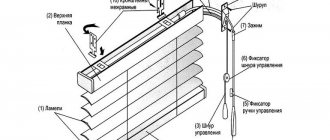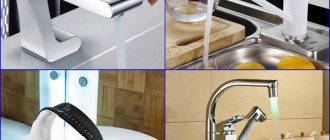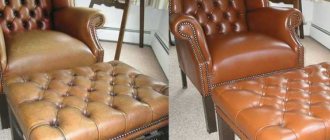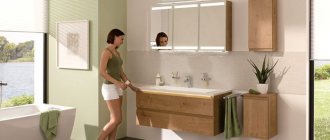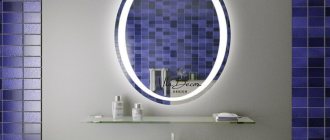A bathroom can be renovated exquisitely, even using the simplest building materials. It is not necessary to buy elite porcelain tiles and lay them on the walls right up to the ceiling, order suspended ceilings, spend money on installing heated floors with marble, it is enough to have a desire to do repairs, the ability to handle tools and a little bit of good taste.
Budget bathroom renovation
What does "budget" mean?
Under the word “budget”, the article will consider finishing options with the most affordable materials:
- paint and varnish;
- PVC panels;
- wallpaper.
In addition, the secret of creating a loft-style interior will be revealed and it will be proven that brick as a finishing material in the bathroom is not inferior to other materials. After all, “budget renovation” can also be stylish.
Budget bathroom design
Loft style in the bathroom
Vintage bathroom
Cosmetic renovation in the bathroom: what's what?
So where to start? If you have decided on the style of the future interior, the bathroom options may look like this:
High-Tech Style
Elements of the East
Retro style
Modern
Art Deco
And with the estimate you plan to meet, the first thing we do is get rid of outdated finishing materials, plumbing fixtures and furniture. Free space leaves a lot of scope for the imagination, and the rich assortment offered by the market of modern materials for bathroom furnishings is ready to satisfy any image.
Experts advise following the following sequence of actions:
- Wall decoration
- Ceiling finishing
- Flooring installation
- Replacement of plumbing
- Bathroom furniture and accessories
The sequence of work may differ depending on the choice of finishing materials for the ceiling and walls.
DIY wall painting
Painting walls is considered one of the easiest and least expensive finishing methods. It is important to choose the right paint and prepare the surface of the walls.
Painted walls in the bathroom
Bathroom decoration
Advice! Create a design project for your bathroom. It is not recommended to paint absolutely all surfaces; it is advisable to cover the areas near the bathtub and sink with moisture-resistant panels or trim them with an apron made of inexpensive ceramic tiles.
Step 1. Choosing paint for the bathroom
Bathroom paint should have antibacterial properties and be moisture resistant. Otherwise, the appearance of fungus and peeling of the coating cannot be avoided.
Moisture resistant paint
Moisture-resistant paint for walls and ceilings
Moisture-resistant paint for walls and ceilings “Optimum”
Moisture-resistant paint for walls and ceilings matte Tikkurila Luya (Luja Tikkurila)
Due to their low cost and excellent performance characteristics, latex, silicone, and acrylic paints are most widely used. At the same time, water-based mixtures do not have an unpleasant pungent odor, and silicone paints can act as a water barrier.
NovaTech Interior paint for walls and ceilings
Traditional oil paints do not have this advantage, and also quickly become covered with cracks, so it is better to immediately abandon this option.
Oil paint
When choosing shades, remember that it is inappropriate to paint small bathrooms in dark colors, as this will visually reduce the space even more. Do not overdo it with the number of bright spots or complex patterns and their quantity so that the interior does not look vulgar. Soft pastel colors will visually expand the room and fill it with light.
Choose shades from the manufacturer's catalog
Please note that paints can be matte, glossy or semi-gloss. Of this variety, it is matte enamels that best hide small defects on the walls, while drops and streaks are clearly visible on glossy surfaces. However, if you cannot make a choice, consider a combination of glossy and matte surfaces. This technique will make your bathroom modern and stylish without significant costs.
The photo shows a combination of matte and glossy paints
bathroom paint
Step 2. Preparing the walls for painting
Don’t forget to remove all the furniture from the bathroom, remove the mirrors, cover the faucets with masking tape, and cover the plumbing fixtures with film or newspaper, because preparing the walls for painting is the dirtiest and most time-consuming stage.
You should not apply new layers of paint over the old peeling one, nothing good will come of it. If you have a drill in your arsenal, get a couple of sanding attachments for it and clean off the old paintwork from the walls. Remember safety precautions.
Removing paint with an angle grinder
Don't have a drill? Use paint strippers, a scraper and a putty knife. The method is effective, but it is better to work with a respirator and thick rubber gloves.
Remover for old paint
Chemical paint removal
Scraper
If the paint on the walls was applied a long time ago, chemicals will not cope with it.
You can remove paint using thermal methods, for example, using a torch or a hair dryer. Heat a section of the wall and scrape off the peeling coating with a narrow spatula.
Removing old paint from walls using a gas torch
When all the old paint has been removed from the walls, it is necessary to repair cracks and potholes and knock down protrusions.
Fill cracks and gouges in the wall
Crack repair
Step 3. Preparing materials and tools
Prepare paint and tools, follow manufacturer's instructions. To apply paint you will need a roller, brushes, if you have a spray gun - great. Before purchasing, measure the area of the surfaces to be coated and adjust the amount of material taking into account the volume. For high-quality painting, it is better to apply two layers, keep this in mind when purchasing.
Brushes, rollers, cuvette
Step 4. Preparing the workplace
Clear the work area near the walls of unnecessary objects; if you are not going to redo the flooring, then cover it with film or paper. Carefully protect the bathtub and sink from contamination.
Protect surfaces with masking tape
Surface protection when painting walls
Start your work from the most inconspicuous corner, in this place you can learn the properties of the paint in practice and, if necessary, dilute it to the optimal consistency. We recommend painting the walls with a roller, and using a brush to treat only hard-to-reach areas, corners and borders of joints of different colors. Panels in the bathroom are still in fashion; if you plan to make them, mark the height on the wall and draw a horizontal line.
Step 5. Start coloring
Apply a deep penetration primer to the wall. It will not only improve the appearance, but also increase the durability of the coating and reduce the likelihood of paint peeling.
Applying primer
Allow the primer to dry for 3-6 hours
Apply a second coat of primer over the first and wait 24 hours
Pour a portion of paint into a special plastic tray for rollers. Dip the roller into it, turn it several times, remove excess paint on a horizontal surface.
Practical advice. To minimize the chance of paint getting on the floor, give the roller a spinning motion before blowing it out of the tray.
Step 6. Painting technology
First paint the surface with a brush along the edges
Start painting from top to bottom, this method reduces the likelihood of drips forming, they are immediately smeared, and the roller “rolls” over them. Paint carefully, do not allow any omissions. Don't be upset if the first coat looks ugly, this is expected. The fact is that there are areas on the wall with old and new plaster, remnants of un-removed coating, etc. They all absorb paint differently, which is reflected in the appearance. The second coat will correct all problems, the finish will be uniform.
Apply the first coat
How to paint walls with a roller
Paint in small areas, correct difficult areas immediately with a brush. The paint should smooth out lint marks on its own. If this does not happen, add solvent to it. Pay attention, so that he is conscientious, read the instructions for use. If in doubt, test the solvent for compatibility with a small volume of material; if the paint has curled, change the solvent.
It is advisable to apply the second layer when the first one is not completely dry, this increases the adhesion coefficient between them. It’s easy to check the readiness of the surface - run your fingertips along it, they should not get dirty, but only “creak” a little.
Paint application scheme
Level the paint along the ceiling by rolling the roller long horizontally without loading it with paint.
If you are making a multi-colored panel, then you need to paint the surface in the second color only after applying two layers of the first. In this case, start working from the top of the wall; the panel is finished last. This way you will be protected from paint getting onto finished areas. Apply masking tape along the border line. Make sure that the paint does not flow under it; paint only with a brush, moving in the direction opposite to the tape. Never apply tape to paint that is not completely dry, this is very important. If you glue it to a freshly painted surface, then during removal it is likely that part of the paint will be removed along with it, and you will have to redo everything.
Marking a wall for striped painting
Apply masking tape
Apply paint
Creating stripes
Stripes can also be horizontal
Original wall decoration
The color transition is achieved by using color and a regular sponge
Example of non-standard wall painting
Preparing the premises
Let's look at this in more detail. So, where to start renovating your toilet and bathroom? First of all, you need to understand that in the vast majority of apartments the restroom has a very small area. As a rule, it is 1.2 x 0.85 meters. Such dimensions greatly limit the possibilities, so you need to immediately decide on an interior design project.
Carefully assess the condition of the room. What exactly does it need - cosmetic repairs or complete reconstruction. If the second option, then you need to start by dismantling the old finish.
In this case, everything happens in the following sequence:
- We disconnect the toilet from the communications, unscrew the fixing bolts and take it out.
- We assess the condition of the pipes. If it is deplorable, then we will also dismantle them.
- Most often, the walls in the toilet are tiled, so we remove them and then clean the work surface using a hammer drill and a special nozzle.
- If you want to carry out quality repairs, it is recommended to immediately start replacing the wiring. We remove the electrical cable from the groove and cut it.
It is worth noting that in some apartments the toilet is combined with a bathroom, so they are constantly damp, which creates ideal conditions for the growth of fungus and mold. To prevent this, you need to treat the walls with special antiseptic agents.
We have described the preparatory stage in detail, so now we can consider the further sequence of repairs in the toilet. Floors, walls, and ceilings require an individual approach, so below we will look at each of them in more detail.
Wall decoration with PVC panels
The cost is slightly more expensive than the first method, but in terms of design indicators it is much better. And the preparatory work is greatly simplified; there is no need to remove old coatings, level the walls and seal cracks in them. The sheathing for the panels can be made from wooden slats or special plastic profiles with clips. We recommend using the second option. The cost of plastic additional elements has almost no effect on the cost of repairs, and the work is greatly simplified. In addition, the plastic profile is not afraid of moisture, which is very important for bathrooms. Wooden slats need to be impregnated with antiseptics - an additional waste of time.
Selecting panels for finishing
Calculate the number of panels needed, make a reserve of 5–10%. If you have little experience, and the bathroom has a lot of utilities, to close which you will need to trim the panels, then take a reserve of 10%. At the same time, estimate the number of starting profiles, external and internal corners. They are sold at a standard price, cost a penny, and there is no need to save money.
Parts for mounting plastic panels
Step 1. Installation of the sheathing
The panels are arranged vertically, the sheathing must be made horizontal. The distance between the planks is 50–60 cm. Make markings on the wall, making sure that the lines are parallel. The sheathing is fixed with dowels, drill holes with a drill and hammer drill, use drills with pobedite tips. To prevent the floor from getting dirty with construction dust, cover the area near the wall with film or paper. Once all the holes are made, remove it immediately. Don’t leave cleaning for later; practice shows that no matter how carefully you work, garbage will definitely spread throughout the bathroom.
Make the holes a few centimeters deeper than the length of the plastic part of the dowels, otherwise you will not be able to insert them all the way, dust will interfere. First, drill the two outer holes, attach the profile, then fix it in several more places. The horizontal distance between the dowels is 60–70 cm.
The pitch of the lathing along the bathroom wall should be 40-50 cm
How to fix elements in one plane?
- Check the condition of the wall with a plumb line, pay special attention to the places where plastic profiles or slats are attached.
- Fix the two outer elements below the level and re-check their position. If there are large recesses where the profiles are attached, then use pads made of different materials. The dowels must attract the profile along the entire plane; there cannot be a gap between it and the wall at the attachment point.
- Stretch ropes between them, two at the ends of the profiles or slats are enough.
- Install all other profiles under the rope; use it to control the position of the slats.
Step 2. Installation of plastic panels
Installation of PVC panels for walls
Panel installation diagram
Take measurements of the wall in at least three places. If they have a spread of no more than a centimeter, then the work is noticeably simplified - all panels can be cut to size at the same time. To do this, you need to find out the shortest one and use it to cut all the others. Stack the panels in stacks of 5–10 pieces. on a flat plane and use a grinder with a metal disc to cut it. A discrepancy of up to one centimeter will be hidden by the ceiling and floor profile. It is installed at the top between the wall and the stream and at the bottom at the junction of the wall and the floor. Place plastic corners on the sides.
A starting angle is installed in the corner. Attaching the starting profile with a stapler
Installation of PVC panels
The installation of panels in the opposite corner is completed by installing a special part - the finishing corner
Professionals finish walls without corners and very precisely cut panels at an angle of 45°. But for this, in addition to extensive practical experience, you need special tools. They are expensive, and it is not economically feasible to buy only for finishing one bath.
Place the first panel and check its position. Everything is fine - secure it with clips. If you have wooden slats, then secure them with staples. Both options provide sufficient reliability of fixing the panels. The first one is mounted - install the second one, press it against the first one until it clicks. It indicates that the elements are connected by a lock. Continue working using this algorithm until the last plastic panel remains. Immediately insert the ends into the corners.
How to attach panels to clamps
Take the exact dimensions of the last panel and cut it lengthwise. You can cut with a mounting knife or grinder. If you use a knife, the operation must be done in two stages. First, cut the top and transverse stiffeners. Second - bend the panel, at the bend on the second side, use a mounting knife to completely cut off the required part.
Finish the remaining walls in the same way. Practice shows that it is better to make the area near the bathtub from ceramic tiles. You don’t have to cover the entire wall, just an apron. The main thing is to close the area that constantly gets water during water procedures.
Wall paneling
Video: Finishing bathroom walls in 1 day with plastic panels. Inexpensive DIY bathroom renovation
No. 6. We organize proper storage
The main problem of modern bathrooms is their insufficient space. Therefore, all things stored in the bathroom should be carefully reviewed and almost empty jars, old washcloths, and unnecessary utensils that only clutter up the space should be thrown away. It is better to store all the really necessary things on closed shelves and in cabinets.
When redecorating your bathroom, you can replace old furniture or restore existing furniture by repainting it or gluing it with film. The mirror can be replaced with a mirrored wall cabinet, a shelf can be hung above the door of the toilet room, and the door itself can be equipped with hooks, baskets and an organizer. Neatly arranged things are the key to making the bathroom feel freer and more spacious.
Wallpapering walls
Wallpaper for the bathroom
Wall decoration with wallpaper
For wallpapering, you can use only waterproof types. This finishing method has a number of undeniable advantages.
- Low cost allows you to have exclusive and reliable coverage with small material losses.
- High technology. Of all the possible ways to decorate walls in a bathroom, wallpapering is the simplest. The work is completed within a few hours, the room can be used for its intended purpose the very next day.
- It is possible to frequently change the design of the premises. In some cases, re-pasting can be done without removing the old one - the repair time is significantly reduced and the amount of construction waste is minimized.
Washable wallpaper
Waterproof wallpaper
Disadvantage: in terms of physical strength, wallpaper is inferior to traditional materials. But, if you behave carefully and avoid mechanical damage, the period can be calculated in many years. In addition, defects on wallpaper can be easily eliminated; after pasting there will always be a small amount of material left. Don't throw it away, keep it “just in case” for repairs.
Which wallpaper to choose for a bathroom
It goes without saying that only waterproof ones. When purchasing, pay attention to physical strength, and it depends on the material of manufacture.
| Wallpaper type | Brief performance indicators |
Vinyl on non-woven base | The most modern ones are distinguished by high levels of mechanical strength and can have long-term direct contact with water. They are produced in a wide range of colors, can be plain or with various patterns and ornaments, with a structured or smooth front surface. Disadvantages - relatively high price, the need to use special glue. |
| Washable | The cheaper segment is inferior in performance characteristics to vinyl. It is recommended to use in areas of the wall that are not exposed to splashes of water. |
Self-adhesive | They are made from a special polymer film and have a huge number of design solutions. Disadvantages - relatively high price and complexity of finishing. In addition, they can only be used on perfectly flat surfaces. |
How to glue wallpaper correctly so that you don’t have to constantly re-glue the peeling areas?
Step 1. Surface preparation
The most important point in the production of work, of course, is not counting the correct choice of wallpaper. The linearity parameters of the wall affect not only the appearance of the wall, which is very important, of course. It is even theoretically impossible to stick waterproof wallpaper on an uneven wall. This means that there will definitely be air pockets and other places where the wallpaper is not glued. While using the bathroom, these areas constantly increase in size, and this continues until the peeling becomes noticeable. Repair will be required; perfectly aligning the wallpaper after repair is quite difficult, and in some cases impossible. What are the requirements for the wall surface?
- Roughness cannot exceed ± 1 mm. Run your hand along the wall, your palm gets scratched badly - that’s a problem. Use a strong steel scraper to cut off any protrusions.
Sand away any rough edges
- For plastering, only durable cement-sand mixtures should be used. All others, under the influence of moisture, significantly reduce their strength indicators, the glue falls off along with the smallest pieces of the solution, and the wallpaper sag.
- The surface must be perfectly dry. There is no air gap between the wall and the wallpaper; natural ventilation is completely absent. Fungus will inevitably appear on a damp wall, and it will certainly destroy the plaster. You will have to make expensive repairs, remove the old plaster, saturate the surface with special chemical compounds (very poisonous, by the way), and plaster and paper the walls again.
- The maximum size of recesses and protrusions cannot exceed several millimeters. Manufacturers tell the truth that some types of wallpaper hide small irregularities. But they don’t say anything about the fact that unglued areas appear in these places with all the negative consequences described above.
Surfaces must be primed in two layers, this increases the reliability of adhesion and serves as additional protection against moisture penetration.
Wall primer
Calculate the surface area, make a small reserve. Each roll of wallpaper is indicated on the length, width and total area. Use this information when purchasing materials. Do the same when choosing glue.
Step 2. Algorithm for gluing vinyl wallpaper
Prepare your tools
Pay attention to the manufacturers' recommendations on which side to apply the glue. There are options for spreading it on the wallpaper, on the wall, or on both surfaces, it all depends on the specific characteristics of the wallpaper.
Glue preparation
Mix thoroughly
Ready-made wallpaper glue
Measure the height and width of the wall, cut the required number of strips. The stripes, depending on the pattern, can be applied end-to-end or overlapping. Cut with a small margin in length, it will then be removed with a knife, the uneven cut will be buried in the ceiling and floor skirting boards.
Cut a strip of wallpaper with scissors or a decorative knife
Make sure that the cut is strictly at right angles
Practical advice. It is most difficult to glue wallpaper in the corners of the room. The fact is that they can have slopes, and this has a negative impact on quality. To prevent such consequences, never make strip joints at the corners; try to have them in the middle in these places.
Next you need to do this.
- Glue the strip coated with glue to one wall of the corner, align it strictly vertically.
- Carefully bend the wallpaper, but not all the way into the corner, lightly glue the strip to the second wall.
- Slowly begin to bend the wallpaper towards the corner, while constantly monitoring the displacement of the second edge, it should always be in a vertical position. An uneven wall angle is not a problem; even if there are air pockets in some places, the main thing is that the edge of the wallpaper on the second wall is vertical.
Definition of vertical
Apply a thick layer of glue evenly with a brush
After applying the glue, fold the left edge of the wallpaper strip towards the middle
Read the wallpaper label to see how long the glue needs to sit on the wallpaper before it sticks to the wall.
If you do not pay attention to this nuance, then on the entire adjacent wall the stripes of wallpaper will be slanted, and this is a big waste.
To apply glue you will need a large room; the bathroom, as a rule, does not have such dimensions. Decide where exactly you will prepare the wallpaper. Take measures to prevent contamination of floor coverings, do not allow glue to get on the front surface. When wallpapering walls, accuracy is one of the important conditions for quality work.
Gluing the first wallpaper
Smooth out wrinkles and bubbles under wallpaper
Cut off the excess
Immediately wipe off excess glue with a damp sponge.
Gluing the second wallpaper
Smooth out wrinkles and bubbles
Carefully squeeze out the air from under the wallpaper. You can use rubber spatulas or rollers. But it is best to do the work with clean, dry hands. This way you will feel the irregularities and be able to eliminate them in a timely manner. It happens that an air pocket is discovered late, several strips of wallpaper have already been pasted. It's not a problem. Poke the air bubble in 2-3 places with a needle, after which you can press the wallpaper again, it will take the desired position.
In the inner corners, stick one strip so that it overlaps the corner by 1-2 cm
Apply the wallpaper across the outer vertical edge of the door frame with a slight allowance, immediately smooth or trim the allowance
Also glue the next strip on top of the frame, smooth it out and cut off the rest from the bottom
Without pressing, cover the switch with wallpaper and make a diagonal cut through it. Carefully cut out the edges and press the wallpaper to the wall
Once the glue has completely dried, cut off the excess length and attach the baseboards. Skirting boards are fastened with liquid nails or other methods, taking into account the material they are made of.
Wallpaper in the bathroom
Floor finishing
So, the toilet renovation has already begun, but to complete it completely, the flooring still needs to be laid. Here, as in the case of other parts of the room, it is very important to assess its condition. As practice shows, waterproofing very often becomes unusable, so it needs to be replaced.
The work is performed in the following sequence:
- The base is completely cleaned of any debris and dust, after which it is treated with a deep penetration primer.
- Next, a special polymer mastic is applied, best made on the basis of bitumen, which will act as waterproofing. Thanks to this, the likelihood of flooding neighbors living on the floor below you will be almost completely eliminated. The layer thickness must be at least 150 millimeters.
- After waterproofing, a concrete screed 50 mm thick is poured. It is best to use quick-hardening mixtures for this. Of course, they cost more than usual, but their quality is much higher, and you will also save a lot of time.
- After the screed has dried, it usually takes 3-4 days, and the working surface is primed.
- It is better to use floor tiles for cladding. It has greater strength and durability, so it will be much more difficult to damage it, and it is also not so slippery when water gets in. If you choose wall tiles, be prepared to replace them just a few years after the renovation.
- The process of gluing tiles is the same as in the case of walls. First, an adhesive mixture is applied to the floor, after which the tiles are laid in rows. When it dries, the joints are grouted. The tiles can be laid either in rows or offset.
That, in fact, is the whole process of work. Now you have a detailed idea of where to start renovating a toilet and how to bring it to the very end. Now all you have to do is arrange the bathroom, and you can start using it.
How to renovate a bathroom in loft style
The style is quite fashionable among young people, but it is difficult for older people to get used to it. The loft style is a method of renovating various premises, including industrial ones, with minimal financial losses. All structures remain in the same place, construction work on surface finishing is carried out without the use of additional materials. Leave old water and sewer pipes in the same place; you can remove the old paint from them and apply new paint. There is no need to try to make them match the wall; on the contrary, use contrasting colors that emphasize the placement of pipelines. If problem areas are identified, correct the problem immediately.
Bathroom interior in loft style
As for the walls, you can remove the old plaster down to the brick, fill large depressions with cement-sand mortar, but do not level or rub it. Wipe the brickwork with a wire brush, trying to highlight the position of each brick. The older the seam and brick, the better, the more modern the loft will be considered. Everything should be simple and natural, no plastic sheathing, plasterboard or other finishing materials.
Brick wall
Brick goes well with wood
To protect the surfaces from inevitable gradual destruction, it is recommended to cover them with moisture-resistant varnish. Before varnishing, carefully remove dust; it is advisable to vacuum the surfaces with a powerful unit. Use only clear varnish. It is advisable to varnish using a pneumatic spray gun. The air jet allows you to process even hard-to-reach areas of the seams, and the strong impact of the varnish drops on the surface increases penetration and adhesion. In addition, repair work is significantly accelerated. And one more plus - old seams can be destroyed while working with a brush, sand will get into the varnish. This is very noticeable on the front surfaces of bricks.
Dismantling work on knocking down old plaster
Apply varnish only to a clean wall
Types of waterproof varnishes
| Type | Performance characteristics |
| Polymer | It has excellent adhesion to brick and concrete, is characterized by high mechanical strength, and due to its plasticity it compensates for dynamic loads. It can be one- or two-component; solvent or toluene is used as solvents. Complete drying time is no more than two hours. |
| Polyurethane | An oligomer containing polymer components was used as a base. Modern coating, occupies a leading position in quality. It is possible to add mineral dyes to change the color. |
| Silicone | The most affordable ones have satisfactory physical and operational characteristics. Prolonged direct contact with water is not recommended. They are odorless, the safest coatings for health, and are approved for use by regulatory government organizations without restrictions. |
Varnish for stone and brick
Professional builders recommend finishing the section of the wall directly next to the bathtub with ceramic tiles, and making the remaining surfaces look like a loft. This approach will allow you to combine modern, fashionable interior design while maintaining the usual level of amenities. Read the link to install the screen under the bathtub.
Start of renovation
Before starting repairs, you should decide on the type of repair work:
- Cosmetic. Involves replacing finishing materials without repairing communication systems. Such repairs can be called superficial. It allows you to radically change the design of a room with little time and financial investment. If the homeowner is thinking about how to renovate the bathroom as quickly as possible, then you need to choose the cosmetic option.
- Capital. This involves replacing old finishes, pipes, plumbing, sockets, repairing the subfloor, etc. Major repairs take longer than cosmetic repairs and require large financial investments, but they are durable.
Painting the walls will help refresh your bathroom renovation
After choosing the type of repair, planning begins, which should include:
- Layout plan for plumbing fixtures and furniture in a renovated bathroom. It is necessary to take into account the location of communication outputs; it may be necessary to completely move and change pipes, connect communications to new equipment, for example, a bidet.
- Cost estimate. You need to decide in advance on the repair budget and calculate all the costs. The repair budget should be planned so as to leave a reserve of 20% of funds. It is necessary to cover unexpected costs: increased prices for materials, replacement of damaged pipes, etc.
- Operating schedule. If you do the repairs yourself, then you should draw up a schedule taking into account your free time and physical capabilities. The procedure for renovating a bathroom can be seen in the video.
Cleaning the premises
Before starting repair work, turn off the electricity and water supply to the bathroom. Then the room must be completely cleaned:
- Throw away old plumbing fixtures, especially if they have scuffs, chips or rust. If the plumbing fixtures have recently been changed, they should be moved to another room for the duration of the repair.
- Dismantle the pipes. Experts do not recommend carrying out renovations in the bathroom without replacing communications. Pipes can leak at any time, ruining the new finish. In addition, old pipes spoil the design of the room and, most likely, take up a lot of space due to their large size and inconvenient location.
- Remove window and door openings.
- Free the horizontal and vertical surfaces of the bathroom from the old finish. If the ceiling in the bathroom was covered with plasterboard, it must be removed. Most likely, mold will be found under the sheets of drywall.
- Take out construction waste.
Before starting work, old plumbing is dismantled
Removing wall decoration
To dismantle wall coverings, you should arm yourself with a hammer drill. To remove ceramic tiles, you will need a concrete chisel, and to remove plaster and paint, you will need an attachment with a metal round brush. During the process of dismantling the finishing, a lot of dust is generated, so all work must be done in a respirator and a protective mask.
All you need to remove old tiles from a wall is a chisel and a hammer.
Attention! If the tile is well preserved, but a crunching sound appears when pressure is applied to it, it means that it has completely moved away from the base. Such tiles are held in place solely by the adjacent tiles, so all the finishing must be dismantled.
Dismantling the floor covering
The flooring should be completely removed from the floor. If there were tiles on the floor, then in addition to removing the tile itself, you will need to remove the remains of the cement base. Then you should carefully examine the concrete screed:
- If it is in good condition, then the concrete is polished using a grinder with a diamond cup.
- If there is at least one crack, the floor should be filled with a liquid leveler or the screed should be completely replaced. The first option is more economical in terms of money and time. If a heavy cast-iron bathtub is installed in the bathroom, then a major replacement of the screed is indispensable.
To remove ceramic tiles from the floor, the same technology is used as for walls.
Pipe replacement
After cleaning the bathroom, you can begin repairing the communication systems. Owners should think in advance about the type of pipes that will be installed in the bathroom. Depending on the material of manufacture, pipes are divided into:
- Iron. They gained their popularity due to their high level of strength and durability. The lifespan of iron products can reach 20 years. The main disadvantage is the appearance of rust.
- Copper. These pipes are practical, environmentally friendly and durable. The main disadvantage of copper products is their high price.
- Polyvinyl chloride. These pipes are inferior to other types in many ways. They are not suitable for installation in the bathroom of a residential building. They have low fire resistance and wear resistance, but the most dangerous thing is that they release harmful substances into the water.
- Polyethylene. The main advantage of polyethylene is its plasticity. If water freezes in a pipe made of this material, then when it expands, the product will not burst. Experts recommend using polyethylene pipes for bathrooms in private homes. They are only suitable for cold water. But cross-linked polyethylene pipes can be used to supply hot water.
- Metal-plastic. They contain polyethylene and aluminum. Such products are not afraid of high temperatures and are characterized by high mechanical strength. To secure them, couplings are used, which can leak at any time. In addition, the quality of metal-plastic pipes depends on the manufacturer.
- Polypropylene. The melting point of this material is 176 degrees, so pipes made from it are ideal for supplying hot water. Polypropylene pipes are hygienic, durable and practical. The pipes are connected by welding.
Before decorating the walls and floors, all communication systems must be installed.
It is better to entrust the replacement of pipes to a plumber to avoid problems with them in the future.
About approximate prices and selection criteria:
- The price for tiles will be from 40 to 60 rubles per piece, depending on the country of origin. On average, the quality of tiles from domestic and European manufacturers does not differ from each other, but European samples usually have a better design. The situation is the same for floor and wall tiles, the only difference is in size. Porcelain tiles will cost more, from 50 rubles per piece, however, it is recommended to use them for flooring. Unlike ordinary ceramic tiles, they have a non-slip surface and greater durability. Considering the rather high traumatic rate of bathrooms in medical statistics, this is an important circumstance. In the store you should pay attention to the condition of the tile surface. The presence of damage on it will lead to the appearance of dirt that cannot be cleaned. To ensure the integrity of the tile you choose, hold it against your face and look at it along the light source. Another factor is the size ratio. If the tiles are of different sizes, and this is quite possible, then during installation the surface will look repulsive, and even if it is not installed, you will have to waste time returning the goods to the seller. To check, take several pairs and place the edges next to each other and take a closer look. The difference in size should not exceed a millimeter. Then test the edges, they should be smooth.
- Tile adhesive. Considering that the work of installing the tiles will be carried out by you yourself, the best choice would be slow-drying glue, from half a day to a day. This will allow you to correct all possible mistakes made and give you the opportunity to work for your own pleasure. The spatula should be selected specifically for the glue, such information is contained on the packaging. If for some reason the packaging does not contain information about the pitch and depth of the teeth, and the glue itself has proven itself well, then choose a shallow depth of 3 to 6 millimeters. Using a trowel with large teeth will likely cause cavities to appear under the tiles.
- Templates for laying tiles. It is best to use plastic crosses because they are easier to work with.
- Grout for tiles. It is not necessary to purchase, since a piece of cable 5-6 millimeters in diameter may be suitable for grouting joints.
- Glass-magnesite sheet from 250 rubles per 1 sheet.
- Laminate from 300 rubles per board.
- Self-leveling floor. For a bathroom, it is preferable to use two components, this is an initial viscous pour, then a liquid one for leveling. The approximate price is from 220 rubles per 10 liters, the same with the insulation effect - from 640 rubles per square meter.
- Teak or larch floor. If you decide to have a wood floor rather than a tile floor. It will cost more, but it looks and feels nicer. Price from 500 rubles per square meter.
- Pipes. The best option is polypropylene pipes: for cold water (PPN) from 24 rubles per square meter, for hot water (PPR) from 35 rubles. The choice is due to the fact that working with steel pipes is difficult; metal-plastic tends to leak in fittings over time, while polypropylene can be welded and hidden in the wall. Sewer pipes start from 45 rubles. We will also include fittings in this category. Fittings made from solid plastic are most preferred, as this will avoid possible leaks. Switching to metal makes sense when connecting pipes to a boiler. The shut-off valves must be spherical and soldered into plastic. The cost of fittings and fittings will be 60% of the price of pipes. When purchasing, measure the outer diameter of the pipe with a caliper. To work with pipes, diamond drills are required; if the sizes do not match, you will have to buy more, and such drills are quite expensive.
- PVA emulsion - from 240 rubles per 5-liter package.
- Plumbing. It all depends only on your choice, let’s just say don’t skimp on quality - plumbing fixtures should serve for a long time and conscientiously. When considering options for heated towel rails, it is recommended to choose a stainless steel heated towel rail. Other options are either of unsuitable quality or overpriced. When choosing a faucet, consider purchasing one with an infrared sensor that automatically turns on the water when you raise your hands to a preset temperature setting. You've probably seen this at airports. The mixer, of course, is not the cheapest, but it will allow you to reduce your water costs by half and heating energy costs by 40-45%.
Prices are approximate and based on current market value. Nevertheless, you will be able to somehow navigate these prices and, taking into account the area, calculate the renovation of the bathroom with your own hands. You will not need everything listed directly when performing the work; some of the presented options are alternatives; their choice will be discussed in more detail below.
Let us repeat once again: you should not be guided by cheapness when choosing materials; their use will only complicate the work. When purchasing materials, take into account possible defects and errors in calculations: there is almost always a need for some reserve. So, with tiles it is recommended to have 3-5% of the excess amount. When renovating a small bathroom, you will do a little more - 5-7%. For other materials add 35-40%.
Now let's get down to work.
